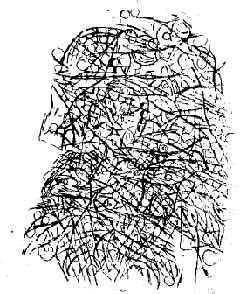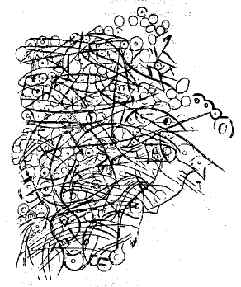|
|
Pataphysics: A Religion in the Making
Asger Jorn
Internationale Situationniste #6 (August 1961)
Translated by Reuben Keehan
The history of religion seems to be made up of three stages — so-called materialist or natural religion, which reached its maturity in the bronze age; metaphysical religion, beginning with Zoroastrianism and developing through Judaism, Christianity and Islam to the Reformation of the 16th century; and finally, Jarry's ideology from the turn of the century, which has ended up laying the foundations of a new religion, a third kind of religion that could very well become the most widespread in the world by the 22nd century: pataphysical religion.
Until recently, the pataphysical enterprise has been attributed no religious significance, quite simply because outside the tiny circle of believers who publish the long running private newsletter Cahiers du Collège de Pataphysique, pataphysics has had no significance at all.
The honor of having introduced pataphysics to the world goes to the Americans, with the publication of a special issue of Evergreen Review that lets the great pataphysical satraps speak for themselves. While word "religion" is obviously never openly mentioned in this issue, the enormous success that it has enjoyed for the past year with the American intelligentsia as brought about a period of objective analysis of this new phenomenon, and it won't be long before they realize what's really at stake.
Natural religion was a spiritual confirmation of material life. Metaphysical religion represented the establishment of an ever-widening opposition between material life and spiritual life. The various degrees of this polarization were represented by various metaphysical beliefs, and were intensified and made all the more backward by an attachment natural rites and cults that were more or less successfully transformed into metaphysical rites, cults and myths. The absurdity of this cultural mythology's persistence at a time when scientific metaphysics have already triumphed was demonstrated clearly by Kierkegaard's choice of confirming Christianity: one must believe in absurdity. The next question was: why? And the obvious response was that secular political and social authorities need to maintain a spiritual justification for their power. This, of course, is a purely material, antimetaphysical argument from a time when the radical critique of all traditional mythologies was beginning.
Prehistoric designs for the Brueil Abbey at the College of Pataphysics. The extravagence and subtlety of the method can be measured by comparing it with Zackarie le Rouzic's "Corpus of Serious Signs of the Megalithic Monuments of Morbihan," which presented a sober and schematic version of the same designs that could be understood without the assistance of the imagination.
|
 |
All sides, however, are calling for a new mythology capable of responding to the new social conditions. It is up this old sidetrack that surrealism, existentialism, and also lettrism have disappeared. The classical lettrists who persevered with this effort have gone even further — further backwards — by carefully assembling all the elements that have actually grown incompatible with a modern and universal belief: the revival of the idea of the messiah, and even of the resurrection of the dead; everything that guarantees the didactic character of belief. Now that politicians possess the means to bring about the end of the world in an instant, anything that has to do with last judgment has become governmental, perfectly secularized. Metaphysical opposition to the physical world has been permanently defeated. The fight has ended in a knockout.
The only winner in this debate is the scientific criterion of truth. A religion can no longer be considered as the truth if it conflicts with what is known as scientific truth; and a religion that does not represent the truth is not a religion. This is the conflict that is about to be overcome by pataphysical religion, which has placed one of most fundamental concepts of modern science at the level of the absolute: the idea that equivalents are constant.
Suitable ground for the theory of equivalents was already prepared with Christianity's introduction of the idea that all men are equal before God. But it was only with the development of science and industry that the principle was imposed in every area of life, culminating, with scientific socialism, in the social equivalence of all individuals.
The fact that the principle of equivalence could not longer be restricted to the spiritual world gave rise to the project of scientific surrealism, already sketched out in the theories of Alfred Jarry. To the Kierkegaardian concept of absurdity, all that was added was the priciple of the equivalence of absurdities (the equivalence of gods among themselves; and among gods, men and objects). Thus, the future religion was founded, the religion that cannot be beaten on its own ground: the pataphysical religion that encompasses all possible and impossible religions of the past, present and future indifferently.
If it were possible for this religion to go into the world completely unnoticed, if pataphysical beliefs were anonymously taught and never criticized, a seemingly irresolvable paradox would not be presented: the problem of pataphysical authority, the consecration of the inconsecrable (that is to say its appearance in social life in the same role as earlier religions). Indeed, this particular religion cannot become a social authority without becoming antipataphysical at the same time, and everything that seeks social recognition finds itself surrounded by this singular fact of social authority. Thus, pataphysical religion could very well be the unconscious victim of its own superiority over every common metaphysical religion, as there is certainly no possible reconciliation between superiority and equivalence.
To its credit, pataphysics has confirmed that there is no metaphysical justification for forcing everyone to believe in the same absurdity. The possibilities of art and the absurd are many. The logical conclusion to this principle could be an anarchist thesis: to each his own absurdity. The opposite is expressed by the legal power that forces every member of society to submit completely to the political absurdity of the State.
But it should be said that the acceptance of a pataphysical authority, such as the one currently being instituted, becomes a demagogic new weapon against the spirit of pataphysics. It is the pataphysical program itself that prevents the existence of a pataphysical program, making a Pataphysical Church impossible.
The impossibility of creating a pataphysical situation in social life also prevents the creation of a social situation in the name of pataphysics. The reasons have already been given. Equivalence is the complete elimination of any notion of situation, of event.
At this time, when pataphysics is, on the outside, very much placed in a certain cultural position, the inevitable consequences of this basic definition necessarily lead to the creation of a schism within the followers of pataphysics between pure anti-situationists and those who, on the pataphysical basis of equivalences, are all the same in favor the development of those organized absurdities known as games.
 The game is the opening of pataphysics onto the world, and the realization of such games is the creation of situations. There is therefore a crisis caused by the crucial problem encountered by every adept of pataphysics: whether they should apply the situological method of becoming socially active, or flatly refuse to act in any situation whatsoever. It is in this instance that pataphysics well and truly becomes the religion most perfectly suited to the modern society of the spectacle: a religion of passivity, of pure absence. The game is the opening of pataphysics onto the world, and the realization of such games is the creation of situations. There is therefore a crisis caused by the crucial problem encountered by every adept of pataphysics: whether they should apply the situological method of becoming socially active, or flatly refuse to act in any situation whatsoever. It is in this instance that pataphysics well and truly becomes the religion most perfectly suited to the modern society of the spectacle: a religion of passivity, of pure absence.
There is also another problem that is no less serious, which demands a choice from the organization of the anti-organizers, the Situationist International. The SI is capable of completely adapting the pataphysical principle as antimetaphysical method: this occurs directly in the establishment of new games. The absurdity of superiority and absurd superiority are the very key to play, and authority is its essential object. By using the principle of equivalents as its point of departure, the game is free: the situation can completely construct itself, in a pure appearance of superiority and authority. But if, on the contrary, a metaphysical basis is chosen, whatever it may be, situology will automatically fall to the level of an authoritarily directed method of popular distraction, a reprise of the old formula of slavery: bread and circuses.
After a long period of maturation in largely ignored circles, the basic elements of a new game are now appearing. Whether these elements are complementary or hostile, only time will tell.
Shortly after his resignation from the SI, Asger Jorn committed himself, with this text and several other interventions, to making the situationists aware of the religious leanings of pataphysical ideology, propagated massively in the United States since the conversion of the editors of Evergreen Review.
Pataphysical ideology, which depends on a few aging participants in various activities in modern art, is itself the product of the aging of this "modern art" of the first half of the century. It preserves cold principles in a joke that is static and uncreative in the extreme. It accepts the world and thus follows the lead of all other religious cliques. "The pataphysician," declares B. Vian over the radio (cf. Dossier no. 12 du Collège), "if he truly has no reason to be moral, has none not to be. That is why he remains the only one with the power to be honest, without the decay of conformists."
It goes to show that the possibilities of the conjunction envisaged by Jorn can only be considered within his perspective of a schism, an apostasy of the least ecclesiastical pataphysicians. The SI believes that any religion is as risible as another; and guarantees a hostility to all religiouns, even science fiction.
|


 The game is the opening of pataphysics onto the world, and the realization of such games is the creation of situations. There is therefore a crisis caused by the crucial problem encountered by every adept of pataphysics: whether they should apply the situological method of becoming socially active, or flatly refuse to act in any situation whatsoever. It is in this instance that pataphysics well and truly becomes the religion most perfectly suited to the modern society of the spectacle: a religion of passivity, of pure absence.
The game is the opening of pataphysics onto the world, and the realization of such games is the creation of situations. There is therefore a crisis caused by the crucial problem encountered by every adept of pataphysics: whether they should apply the situological method of becoming socially active, or flatly refuse to act in any situation whatsoever. It is in this instance that pataphysics well and truly becomes the religion most perfectly suited to the modern society of the spectacle: a religion of passivity, of pure absence.